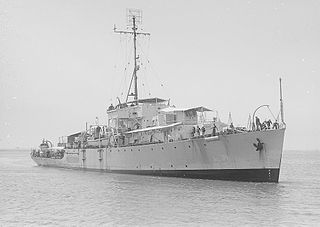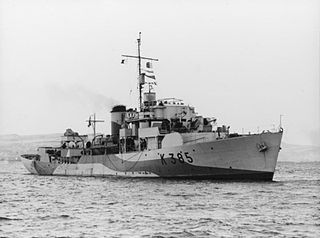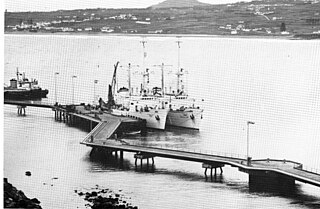
HMAS Lachlan (K364/F364) was a River-class frigate that served the Royal Australian Navy (RAN) from 1945 to 1949. The vessel was later transferred to the Royal New Zealand Navy serving as surveyor until 1975 and was eventually scrapped in 1993.

The Royal New Zealand Navy is the maritime arm of the New Zealand Defence Force. The fleet currently consists of nine ships. The Navy had its origins in the Naval Defence Act 1913, and the subsequent purchase of the cruiser HMS Philomel, which by 1921 had been moored in Auckland as a training ship. A slow buildup occurred during the interwar period, and then perhaps the infant Navy's most notable event occurred when HMS Achilles fought alongside two other Royal Navy cruisers at the Battle of the River Plate against the German ship, Graf Spee, in December 1939.

USNS Mizar (MA-48/T-AGOR-11/T-AK-272) was a vessel of the United States Navy. She was named after the star Mizar.

HMNZS Resolution (A14) was a hydrographic ship of the Royal New Zealand Navy (RNZN). Originally the United States Naval Ship USNS Tenacious (T-AGOS-17), the Stalwart-class ocean surveillance ship was used by the United States to locate and track Soviet submarines from 1989 to 1997, when she was transferred to the RNZN for use as a hydrographic survey ship. She served until 27 April 2012. She was subsequently sold to EGS Group, a private surveying company, and renamed RV Geo Resolution.

HMNZS Wellington was a Leander-class frigate of the Royal Navy and the Royal New Zealand Navy (RNZN). Originally commissioned in 1969 for the Royal Navy as HMS Bacchante, she joined the RNZN in 1982. She was decommissioned in 1999 and sunk in 2005.

HMNZS Otago (F111) was a Rothesay-class frigate acquired from the United Kingdom by the Royal New Zealand Navy (RNZN) before completion.

HMNZS Waikato (F55) was a Leander Batch 2TA frigate of the Royal New Zealand Navy (RNZN). She was one of two Leanders built for the RNZN, the other being the Batch 3 HMNZS Canterbury. These two New Zealand ships relieved British ships of the Armilla patrol during the Falklands conflict, freeing British ships for deployment.

HMNZS Rotoiti (F625) was a Loch-class frigate of the Royal New Zealand Navy (RNZN), which had formerly served in the British Royal Navy as HMS Loch Katrine at the end of World War II.

HMNZS Manawanui (A09) was commissioned in 1988 as a diving support vessel for the Royal New Zealand Navy. Originally she was built as a diving support vessel, the Star Perseus, for North Sea oil rig operations.

HMNZS Arabis was a modified Flower-class corvette of the Royal New Zealand Navy (RNZN). Built for the British Royal Navy as HMS Arabis, she was transferred to the RNZN on completion. She was commissioned in 1944 and decommissioned in 1948.

HMNZS Endeavour (A11) was a fleet oiler for the Royal New Zealand Navy. She was named after James Cook's Bark Endeavour and the third ship in the RNZN to carry that name, though if continuity with the Royal Navy ships of the name HMS Endeavour is considered, she is the twelfth. The previous two ships of the RNZN were Antarctic research support vessels. Endeavour was built in South Korea to a commercial design and commissioned on 8 April 1988, and decommissioned on 15 December 2017.

HMNZS Canterbury (F421) was one of two broad beam Leander-class frigates operated by the Royal New Zealand Navy (RNZN) from 1971 to 2005. She was built in Scotland and launched in 1970. Commissioned in 1971, Canterbury saw operational service in much of Australasia and other regions like the Persian Gulf. She undertook operations such as supporting UN sanctions against Iraq and peace-keeping in East Timor. With her sister ship HMNZS Waikato she relieved the Royal Navy frigate HMS Amazon in the Indian Ocean during the Falklands War. Early in HMNZS Canterbury's career, in 1973, she relieved the frigate HMNZS Otago, as part of a unique, Anzac, naval operation or exercise at Moruroa during anti-nuclear protests, supported by a large RAN tanker, providing fuel and a large platform for Australian media. This was due to F 421 being a more modern RNZN frigate, with then current Rn surveillance radar and ESM and a more effectively insulated frigate from nuclear fallout, with the Improved Broad Beam Leander steam plant, for example, being remote controlled and capable of unmanned operation and therefore the ship provided a more effective sealed citadel for operations in areas of nuclear explosions.
The Bird-class minesweeper was a class of naval trawlers built for the Royal New Zealand Navy and which served during the Second World War. A total of three vessels in the class were built: Kiwi, Moa and Tui. All were named for New Zealand native birds and were also referred to as corvettes.

HMNZS Tui (T234) was a Bird-class minesweeper of the Royal New Zealand Navy. She was commissioned in 1941 for minesweeping and anti-submarine roles. Tui was the first of two ships with this name to serve in the Royal New Zealand Navy and was named after a native bird from New Zealand.
HMNZS Moa (T233) was a Bird-class minesweeper of the Royal New Zealand Navy (RNZN) that served during World War II.

HMNZS Philomel is the main administrative naval base of the Royal New Zealand Navy. Originally a training base on board the cruiser it takes its name from, it is part of the Devonport Naval Base in North Shore City, Auckland, New Zealand.
HMNZS Monowai (A06) was a hydrographic survey vessel of the Royal New Zealand Navy (RNZN). Built in 1960, the ship was originally used as a civilian supply and passenger vessel by the New Zealand Government, under the name GMV Moana Roa, before being acquired by the RNZN in 1974. She was commissioned into the RNZN in 1975 for the voyage to Scotland for conversion and commissioned into the RNZN in October 1977. She remained in RNZN service until April 1998, performing various duties such as coastal surveying, resupply, and surveillance. After being decommissioned she was sold to civilian operators in Britain in 1998 for conversion to a cruise ship, but was found unsuitable for the role and eventually sent to Spanish shipbreakers in 2002.
HMNZS Manawanui was a naval tug which was modified for use as a diving tender by the Royal New Zealand Navy (RNZN). Originally intended for service with the United States Navy as a tug, the vessel was built in 1945 and transferred to the New Zealand Marine Department, which employed her in Waitemata Harbour before transferring the ship to the RNZN in 1948. She was converted to a diving tender in 1953 and served out her time in the RNZN in this role, before being decommissioned in 1978 and sold to the Paeroa Historic Maritime Park. The engine is now on display at the Whangarei Stationary Engine Club.
HMNZS Santon (M1178) was a Ton-class minesweeper that operated in the Royal Navy, the Royal New Zealand Navy (RNZN), and the Argentine Navy. Built for the Royal Navy by Fleetlands Shipyard of Portsmouth, the minesweeper was launched on 18 August 1955 and commissioned as HMS Santon. She was named after a small village in North Lincolnshire. The minesweeper was commissioned in the RNZN from 1965 to 1966, when she was returned to the United Kingdom. She was later transferred to the Argentine Navy, and operated as ARA Chubut (M3).

USNS Sands (T-AGOR-6) was a Robert D. Conrad-class oceanographic research ship operated by the Military Sealift Command (MSC) for the Naval Oceanographic Office from 1965 to 1973. During that period she provided ocean-bottom information and underwater test data to the U.S. Navy and other U.S. agencies. The ship was the second naval vessel to be named for Rear Admiral Benjamin F. Sands and his son Rear Admiral James H. Sands, the first being the destroyer Sands (DD-243). The ship operated in the Atlantic on oceanographic and geophysical assignments for the Oceanographic Office and other agencies.














